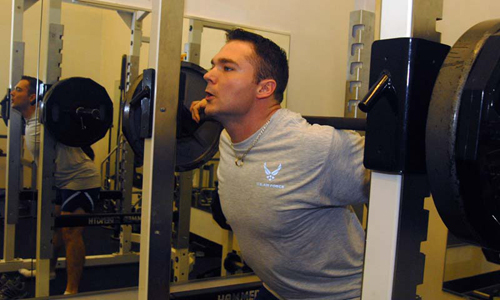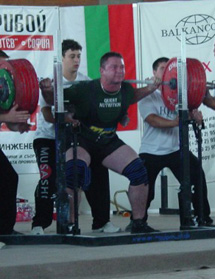An RTS Overview
by Mike Tuchscherer

So the Reactive Training Manual has been available for over a year now. In that time RTS as a business has grown and changed a lot. A positive aspect of that growth is that more and more people are discovering RTS and seeking knowledge on the system. It is in this regard that I realized that there are a lot of people who would like to know the basics of what this training system is all about, but in the midst of forum moves and website updates, a lot of this information is not readily available. So I’d like to re-introduce RTS for everyone, especially those who don’t know what it’s all about.
Learning to listen
If you read much about training, you’ll find that there is a ton of information available on how to train if you’re a beginner powerlifter. And the highly advanced lifters know how to train for their body type and individual differences. But what if you’re an intermediate powerlifter? You grasp the basics and you’re trying to learn how to be a better, stronger, and more intelligent powerlifter. If you listen to guys talk, you’ll probably hear it suggested that you “listen to your body” in some capacity or other. As an intermediate lifter, how do you do that? If you train in conjunction with a good coach, you might learn it, but how many of us have that luxury?
Answering this problem is where the Reactive Training System started, but as I continue my education, I’ve learned that it’s even more important than I originally thought. The Law of Individual Differences states that each person will respond somewhat differently to a training stimulus (or any stimulus for that matter). So what works for one person may not work for another person. Also, there are physiological differences from person to person and it’s important that these be accounted for as well.
But how does any of that help the intermediate lifter? RTS is a system of tools designed specifically to help you learn how to listen to your body and make the best training choices as a result. Although the manual itself contains the tools to make a complete program, the tools aren’t limited to that. RTS tools are designed to be like the scope on a rifle. You can put the “scope” of RTS on any program you choose and it will help. At the same time, if you pair RTS with crappy training, then you still get crappy results. RTS was originally designed to be training enhancement, although there are plenty of programming tools covered in the manual.
Some of those tools are described below:
RPE’s
RPE stands for Rate of Perceived Exertion, which is a nice term for, “how hard did it feel”? It is a numerical scale of 1-10 with a key part of the reading being the lifter’s assessment of how many reps they had left in the tank. For example, if I did a set of 3 and when I rack the weight, I can honestly say, “yeah, I could’ve done 1 more rep”, then that is a 9 RPE. For more information, see the Chapter 2 excerpt.
Custom Template design
Building your own template is an important process. Let’s be honest, none of us are professional lifters that can lift weights for 8 hours a day, 7 days a week. So time management is an issue. There are a huge number of stock size templates that are available, but for many of us, those just don’t work all the time or they fail to take something into account. The answer to this would be to build your own template that is custom-designed to fit your lifestyle and time management restrictions.
Some things to keep in mind when building your own template: when will I have access to certain equipment? How much time will this workout take? How do these exercises fit together with each other? How does this workout fit with the workouts around it? Answering these questions will keep your template design on track and, as long as you cover all your required work, it should be effective because it fits best with your life. I’m not saying it’s optimal, but maybe it’s optimal for you at this moment of your life due to other circumstances.
If you would like to learn more on template design, but This is touched on in the book and covered in much more detail in the Seminar DVD.

Fatigue Percents
These really help customize a program by allowing the volume to fluctuate depending on your current state of readiness. If you are resistant to fatigue, you would use more volume to stimulate your system. If you were susceptible to fatigue, you will fatigue easily and thus require less volume. Fatigue Percents allows your volume to automatically adjust to what you need that day. The way this is measured is via a drop in your ability to display strength due to fatigue. It requires you to arrive at an “initial” – or a set that displays your strength potential that day. This could be a set of either a 9 or 10 RPE. The subsequent fatigue is measured via percentage. So if you work up to 3 reps with 300 pounds at a 9 RPE, then continue working until 285 for 3 reps is a 9 RPE, you have acquired 5% fatigue. Low stress workouts are ones that generally leave you with 3% or less fatigue. Medium stress usually results in a 5% fatigue percent. High stress is associated with 7%+ fatigue percents.
These are just a few of the basic tools of the Reactive Training System. As always there is much more to learn including Stress Management, cycle planning, execution methods, and so on. However, hopefully this article provides you with an outline of what RTS is all about and at least allows you to start training according to your body’s needs.
Mike Tuchscherer is the owner of Reactive Training Systems, a company dedicated to individualized physical training. The goal of RTS is to help you become a dominant force in your sport! Learn more by visiting www.ReactiveTrainingSystems.com.
Mike himself is an accomplished Powerlifter. He has over 12 years of experience training and researching the best training methods in the world. Mike has competed in raw and single ply competitions. He recently won the Gold medal representing the USA at the 2009 World Games; becoming the first American male to ever win this distinction. His best lifts in IPF competition are a 903 squat, a 644 bench press, an 826 deadlift, and a 2342 total in the 275 pound weight class.
More Articles By Mike Tuchscherer
Return to the Workout Articles Archive
|